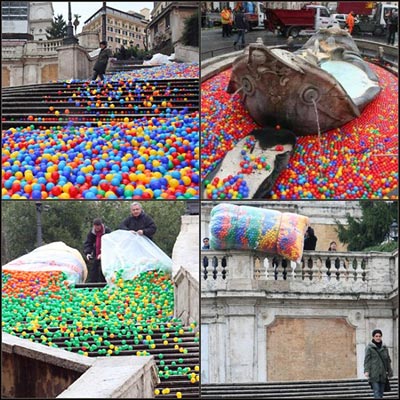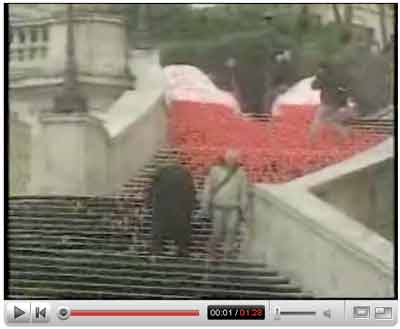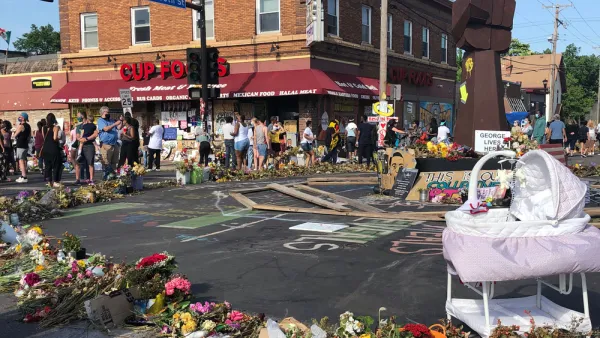The other day, half a million plastic balls bounced down the Spanish Steps, one of Rome's most visited and historic public places. Many visitors, picture-takers and members of the media were caused to wonder 'what's up with all these balls?'
The other day, half a million plastic balls bounced down the Spanish Steps, one of Rome's most visited and historic public places. Many visitors, picture-takers and members of the media were caused to wonder 'what's up with all these balls?'

(photo by Flickr user mareadjrock)
What's up, in my perspective, is a reminder that the public places of the world truly do belong to us all -- and are subject to whatever beautiful, horrible and cracked-out things we want to use them for.
The guy who dropped the balls says he was trying to represent the Italian government's "corrupt" system, with each ball representing a lie told by politicians. Graziano Cecchini, the same guy who dyed the waters of Rome's Trevi Fountain blood red in October, was promptly detained by police after emptying bags full of thousands of small plastic balls at the top of the historic staircase.
The video linked above shows the flow of balls down the staircase as confused and amused onlookers look on. It's a real-life, though less compelling, version of a commercial from a couple years back in which a bunch of bouncy balls were dropped down a hill in San Francsico by a private company to sell TVs.
You could call what Cecchini did vandalism, activism, littering, public art, or any number of adjectives. But the definition doesn't really matter as much as the (probably unintentional) statement it makes about the utility and inherent democracy of public spaces. These are places built for use and reinterpretation by the public. Especially in older cities, the public for whom these public spaces were originally built have been dead for hundreds of years, meaning the places are subject to be used and abused as the subsequent publics decide. This can take the form of riots, farmers markets, parades, and, yes, a staircase covered with balls.
This act is a reminder that we need to keep public ownership of our historic public places, and sustain that mentality as our cities build new places intended for the public. A recent article from the Los Angeles Times Magazine looking at the new public spaces being built in the city determined that nearly all of them were "shaped, controlled or compromised by private, commercial or other interests." Many things in our modern lives are owned or sponsored or presented by some major corpooration, and I assume the public spaces in other cities beyond L.A. are experiencing the same "privatization" discussed in the article.
Cecchini's balls (which, you have to admit, must be huge) are an exercise in civil disobedience and a call to urban dwellers everywhere to keep public spaces truly public. That means accessible, usable, unpredictable, and, like some famous guy once said, of the people, by the people, and for the people.

Analysis: Cybertruck Fatality Rate Far Exceeds That of Ford Pinto
The Tesla Cybertruck was recalled seven times last year.

National Parks Layoffs Will Cause Communities to Lose Billions
Thousands of essential park workers were laid off this week, just before the busy spring break season.

Retro-silient?: America’s First “Eco-burb,” The Woodlands Turns 50
A master-planned community north of Houston offers lessons on green infrastructure and resilient design, but falls short of its founder’s lofty affordability and walkability goals.

Test News Post 1
This is a summary

Analysis: Cybertruck Fatality Rate Far Exceeds That of Ford Pinto
The Tesla Cybertruck was recalled seven times last year.

Test News Headline 46
Test for the image on the front page.
Urban Design for Planners 1: Software Tools
This six-course series explores essential urban design concepts using open source software and equips planners with the tools they need to participate fully in the urban design process.
Planning for Universal Design
Learn the tools for implementing Universal Design in planning regulations.
EMC Planning Group, Inc.
Planetizen
Planetizen
Mpact (formerly Rail~Volution)
Great Falls Development Authority, Inc.
HUDs Office of Policy Development and Research
NYU Wagner Graduate School of Public Service



























